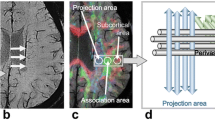Summary
By histochemical as well as by chemical evidence it has been shown that CA from human brain contain a glycogen-like substance, to which phosphate-and sulphate groups are bound.
In this study the CA have been studiedin situ and after isolation. The CA were obtained from formaldehyde fixed tissue, which by histological reactions was shown to be rich in these bodies. First the tissue was defatted with chloroform-methanol. Then the defatted tissue was repeatedly digested with papain and the CA were isolated after each proteolytic treatment by centrifugation in 2 M sucrose. The purified CA contained up to 80% of a glycogen-like substance, 1.1% phosphate and 0.72% sulphate.
The histochemical reactions such as PAS, PAS-dimedone, Best's carmine, toluidin blue and uranyl nitrate, as well as the effect of treatment with α-amylase, DNase and hyaluronidase on these colour reactions are in agreement with the results of the chemical analysis. All reactions on lipids, nucleic acids and sialic acid were negative. Protein, which by chemical analysis was found to amount to about 5%, was hardly detectable by histological reactions.
Similar content being viewed by others
References
Alder, N.: On the nature, origin and distribution of the corpora amylacea on the brain with observations on some new staining reactions. J. ment. Sci.99, 689–697 (1953).
Bulmer, D.: Dimedone as an aldehyde blocking reagent to facilitate the histochemical demonstration of glycogen. Stain Technol.34, 95 (1959).
Bravi, G.: The histochemistry of the corpora amylacea of the central nervous system. J. ment. Sci.98, 221 (1952).
Cessi, C., Piliego, F.: The determination of amino sugars in the presence of amino acids and glucose. Biochemistry77, 508–510 (1960).
Diezel, P. B.: Histochemische Untersuchungen an den Corpora amylacea des Zentralnervensystems. Zugleich ein Beitrag zur formalen Genese. Verh. dtsch. Ges. Path.39, 199–226 (1956).
Dische, Z.: A new specific colour reaction of hexuronic acid. J. biol. Chem.167, 189–198 (1947).
Donders, R.: Cited by R. Stürmer: Nissl and Alzheimer Arb.5, 417 (1913).
Gibbons, R. A., Wolfrom, M. L.: Hydrolytic sensitivity of the sulfo-amino group in heparin and in model compounds. Arch. Biochem. Biophys.98, 374–378 (1962).
Glegg, R. E., Clermont, Y., Leblond, C. P.: The use of lead tetra-acetate, benzidine, o-dianisidine and a “film test” in investigating the periodic-acid-Schiff technic. Stain Technol.27, 277 (1952).
Heycop ten Ham, M. W. van: Lafora's disease. Review and histochemical aspects. Arch. Neurobiol.28, 647–666 (1965).
Jonge, J. M. de: Een histochemische studie van Corpora Amylacea, Thesis, Vrije Universiteit, Amsterdam 1962.
Landsmeer, J. M. F.: Some colloid chemical aspects of metachromasia. Acta physiol. pharmacol. neerl.2, 112–128 (1951).
Meyer, K. H., Odier, M.: The mucopolysaccharides of the ground substance of connective tissue. Experientia (Basel)2, 311–312 (1946).
Molnar, J.: Corpora amylacea in the central nervous system. Nature (Lond.)168, 39 (1951).
Morrison, W. R.: A fast, simple reliable method for the microdetermination of phosphorus in biological materials. Analyt. Biochem.7, 218–224 (1964).
Puchtler, H., Sweat, F., Kuhns, J. G.: On the binding of direct cotton dyes by amyloid. J. Histo-Cytochem.12, 900–907 (1964).
Recklinghausen, V.: Handb. der allgem. Pathol., p. 397. Stuttgart 1883.
Rieder, H. P.: Verbesserung zur Methode der Eiweißbestimmung mittels Cu-II und Phenolreagens nach Folin-Ciocalteu. Clin. chim. Acta4, 733–736 (1959).
Roukema, P. A.: Isolation and preliminary characterization of corpora amylacea from human brain. In Abstracts of the 6th FEEBS Meeting, Madrid, 7–11 april 1969, p. 270.
Roukema, P. A., Oderkerk, C. H.: Isolation and preliminary characterization of corpora amylacea from human brain. Psychiat. Neurol. Neurochir. (Amst.)73, 87–96 (1970).
Sakay, M., Austin, J., Witmer, F., Trueb, L.: Studies of corpora amylacea. I. Isolation and preliminary characterization by chemical and histochemical techniques. Arch. Neurol. (Chic.)21, 526–544 (1969).
Smith, M. C.: Metachromatic bodies in the brain. J. Neurol. Neurochir. Psychiat.12, 100 (1949).
Stam, F. C.: New histochemical and colloid chemical aspects of leucodystrophy. Psychiat. Neurol. Neurochir. (Amst.)63, 237–245 (1960).
Steele, H. D., Kinley, G., Leuchtenberger, G., Lieb, E.: Polysaccharide nature of corpora amylacea. Arch. Path.54, 94–97 (1952).
Stürmer, R.: Die Corpora Amylacea des Zentralnervensystems. Nissl and Alzheimer Arb.5, 417 (1913).
Virchow, R.: Verh. der physik. med. Ges. zu Würzburg, Bd. II, S. 51 (1851).
Warren, L.: The thiobarbituric acid assay of sialic acids. J. biol. Chem.234, 1971–1975 (1959).
Author information
Authors and Affiliations
Rights and permissions
About this article
Cite this article
Stam, F.C., Roukema, P.A. Histochemical and biochemical aspects of corpora amylacea. Acta Neuropathol 25, 95–102 (1973). https://doi.org/10.1007/BF00687554
Received:
Issue Date:
DOI: https://doi.org/10.1007/BF00687554




